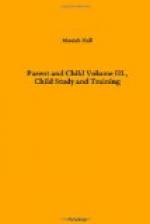The school was never before so practical in its instruction as it is to-day. In most of the junior and senior high schools, industrial work and agriculture are taught. In the best schools girls are learning to sew, mend, darn and cook. Many of them make their own dresses and trim their own hats. In a few schools, uniform dress and shoes are adopted by the girl students for the sake of economy and to prevent the silly mode of dressing and the style of some girls. Much more could be done in this direction if all mothers were sensible, but now and again word comes to the teacher: “I can dress my girl well and I don’t care to have her wear your cheap uniform and your low-priced, low-heeled shoes.” And again: “It’s none of your business how my girl dresses.” Now, it must be conceded that the parent has this right to object, but we surely question the wisdom of her so doing. Many young girls on graduating from the eighth grade make their own graduation dresses and confine the cost of the entire costume, including shoes, to $5.00. Women graduating from the senior school often make their dresses and confine the cost to within $10.00.
Most young men are taught manual art of some kind and agriculture. It is seldom that any father objects to his son taking carpenter work, but once in a while a farmer smiles at the thought of a “professor” teaching farming. The results, however, of the good work in teaching better farming is already seen throughout our country, and the time is not far distant when “scientific agriculture” will return many fold the price of its investment. The agricultural department at Washington reports that the Burbank potato is adding $17,000,000 yearly to the wealth of the U.S.
The people, too, are well satisfied with this new type of school. They are beginning to see that education is a very practical and vital matter and is not merely for ornament. It is a rare thing now to hear the once common remark that education is too expensive.
Statistics show that the average wages paid to unskilled laborers in the U. S. is about $500 per annum; careful reports indicate that the average yearly earnings of high school graduates is $1000. In a lifetime of 40 years the high school man will earn $20,000 more than the unlearned laborer.
From a financial standpoint it is very evident that education pays, yet five and one-half years is the average length of time the children of the U.S. attend school. The nation ought to enrich itself through putting more money into education.
The natural resources of the country are largely taken up and the free land is practically all occupied. What then is to be the future of the great mass of laborers unless a thorough-going system of industrial and vocational training is made possible? The Industrial Commission appointed recently by Congress found that three-fourths of the male laborers in the U.S. earn less than $600 per annum, yet the U.S. Government has found “that the point of adequate subsistence is not reached until the family income is about $800 a year. Less than half the wage-earners’ families in the U.S. have an annual income of that size.”




